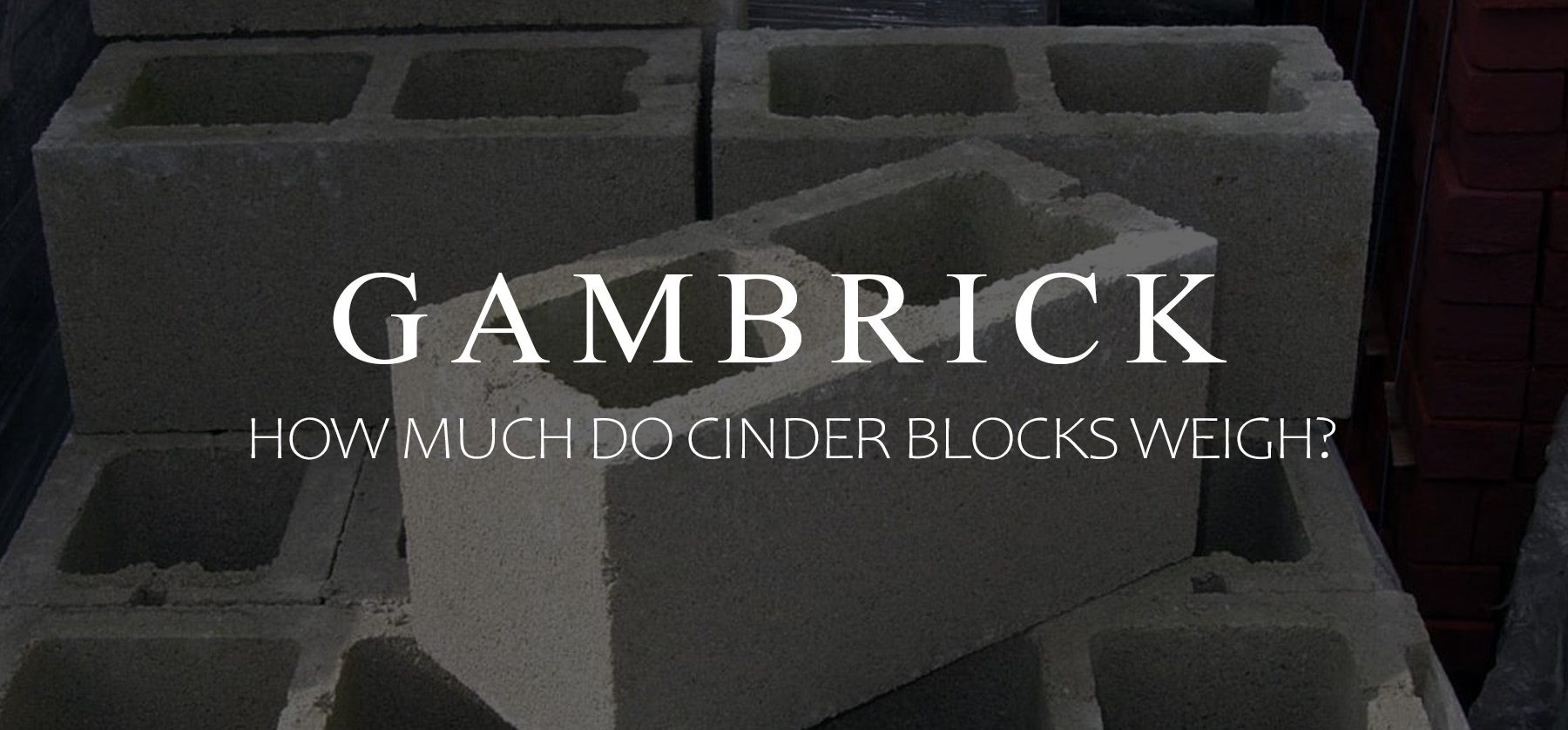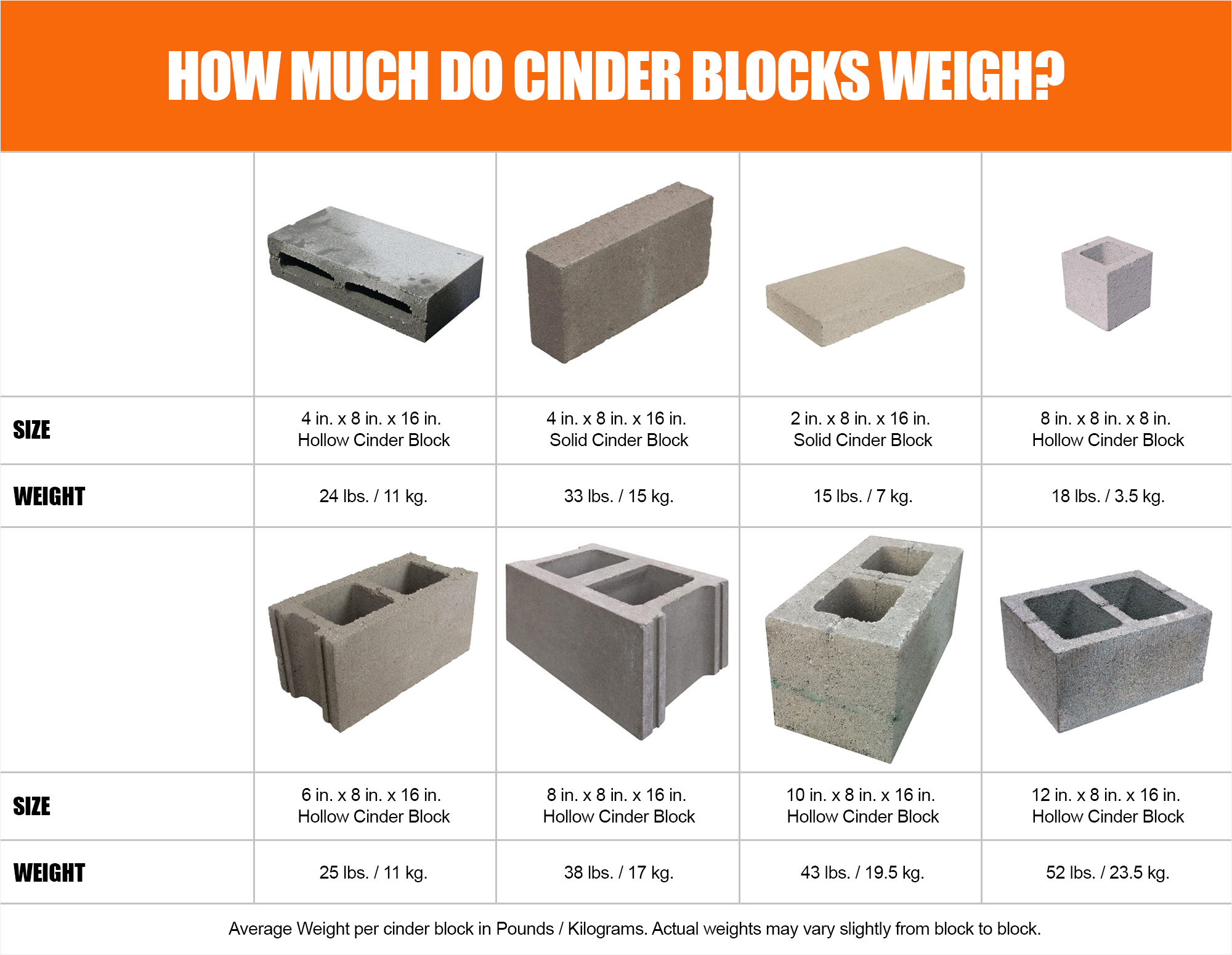How Much Do Cinder Blocks Weigh?
A cinder block is also referred to as a Concrete Masonry Unit or CMU. They’re rectangular blocks used in building construction and come in a variety of sizes. Cinder blocks generally have a hollow core which provides space for vertical rebar reinforcement. These hollow areas, called cells, can be filled solid with concrete to provide even more strength. Cinder blocks are structural and are commonly used to build foundation walls. They’re installed one at a time and held together by mortar joints. Typically a cinder block wall is built atop a strong solid concrete footing. How much cinder blocks weigh depends on the size of the block and its density. One of the most common size cinder blocks used in construction, called the standard block, is 8 in. x 8 in. x 16 in. and it weighs 38 lb. / 17 kg.
Concrete blocks are made from cast concrete. The concrete used to make a cinder block contains cement and aggregate. The aggregate may contain cinder materials like industrial waste, fly ash, coal dust, bottom ash, recycled materials, slag cement or recycled aggregate. The ash is what gives concrete blocks their nickname cinder blocks.
Cinder blocks are designed to be lightweight blocks, also known as low-density block. However they can still be quite heavy. A 12 in. x 8 in. x 16 in. hollow cinder block weighs 52 lb. / 23.5 kg. per block.
Cinder blocks come in a variety of designs which are used for different purposes. These include hollow and solid core blocks, lintels, stretcher blocks, pillar blocks, partition blocks and corner blocks.
In this article we’ll discuss the different types of cinder blocks and how much they weigh.
How Much Does A Cinder Block Weigh?
Cinder block are an economical building material with a wide range of construction applications. They’re used in both residential and commercial construction.
Cinder block walls are strong, easy to build, versatile and relatively affordable when compared to their strength. They’re commonly used to build walls with a variety of uses which includes structural applications like foundations. In fact, most homes built in the U.S. have foundation walls built out of cinder block.
The weight of a cinder block depends on its size and density. The bigger and denser the block, the more it weighs.
Cinder blocks come in different shapes, sizes, and types which are designed for different applications.
The weight of a cinder block is based on its dry weight. Cinder blocks are porous and absorb water which increases their weight. The larger and denser the block, the more water it can absorb. A water soaked block can easily weigh over a pound heavier than a dry block. Keep this in mind when working with wet cinder blocks. They’ll not only feel heavier than they should but moisture will make the mortar joints dry slower.
Ahead we’ll look at the most commonly used blocks along with their sizes and weights.
Cinder Block Sizes
Before we start talking about the different cinder block sizes and how much they weigh, you need to understand a blocks dimensions.
A cinder block has 3 dimensions, width, height and length. And the dimensions are almost always shown in that order. For example, the standard 8x8x16 cinder block is 8 inches wide x 8 inches tall x 16 inches long.
The standard height of most full size cinder blocks is 8 inches high. And the standard length of most full size cinder blocks is 16 inches long. The variable dimension of a full size cinder block is it’s width.
When masons refer to a 4 inch, 6 inch, 8 inch, 10 inch or 12 inch cinder block, they’re talking about the block’s width. The height and length are always 8 inches high x 16 inches long.
Non-standard size blocks are available for all sorts of purposes. For example, 4 inch high and 2 inch high blocks are used as cap blocks and lintels are designs to span long spaces. Special blocks like these are not typically 8 inches tall or 16 inches long.
The bigger and denser the cinder block, the heavier it is. This is because the concrete used to make the blocks are basically the same. It’s only the blocks size and design that effects its weight.
How Much Does An 8 x 8 x 16 Cinder Block Weigh?
Let’s start by discussing the 8 in. x 8 in. x 16 in. cinder block because it’s the most common size used in construction. This may be referred to as an 8 inch block or a standard block. They typically have 2 hollow cells which can be filled with rebar and concrete. You can buy them at any Home Depot or Lowes and they’re generally in stock.
How much does an 8 inch cinder block weigh? The typical weight of an 8 inch cinder block is 38 lb. or 17 kg.
Remember, this is a dry weight. When a cinder block this size is soaked it can easily weigh over a pound heavier.
How Much Does A 6 x 8 x 16 Cinder Block Weigh?
The 6 in. x 8 in. x 16 in. cinder block is slightly smaller in width than the 8 inch block. They’re commonly refereed to as a 6 inch block. Because they’re smaller, a 6 inch block can’t support as much weight as a larger 8 inch block. However, they can be used to build all sorts of walls and foundations. We usually use them along side larger blocks to form angles and areas of wall that don’t support much weight.
How much does a 6 inch cinder block weigh? A typical 6 inch cinder block weighs 25 lb. or 11 kg.
This is dry weight. Cinder blocks are all porous and absorb water. If a 6 inch block is soaked it can weigh about a pound more.
How Much Does A 10 x 8 x 16 Cinder Block Weigh?
A 10 in. x 8 in. x 16 in. cinder block is an upgrade from the standard 8 inch block. They’re heavier and can generally support more weight. Typically a 10 inch block has two hollow cells that can be filled with rebar and concrete.
How much does a 10 inch cinder block weigh? A typical 10 inch cinder block weighs 43 lb. or 19.5 kg.
This is dry weight. A 10 inch block can absorb over a pound of water when fully soaked.
How Much Does A 12 x 8 x 16 Cinder Block Weigh?
A 12 in. x 8 in. x 16 in. cinder block is one of the largest cinder block we use in construction. They’re heavier than a standard size 8 inch block which means they can support more weight. Usually a 12 inch block has two hollow cells for rebar and concrete.
How much does a 12 inch cinder block weigh? A typical 12 inch cinder block weighs 52 lb. or 23.5 kg.
This is dry weight. A fully soaked 12 inch block can carry over a pound of water.
How Much Does A Solid 2 x 8 x 16 Cinder Block Weigh?
A 2 in. x 8 in. x 16 in. cinder block is a solid core specialty block. It’s used primarily as a cap block or as a temporary support. On job sites they’re commonly referred to as pancake blocks. Many above ground pools have their frame posts built atop these 2 inch pancakes.
2 inch blocks are solid all the way through and don’t contain any cells. This makes them heavy for their size.
How much does a 2 inch solid cinder block weigh? A typical 2 inch cinder block weighs 15 lb. or 7 kg.
This is dry weight. Because solid blocks are porous and contain thicker concrete, they can absorb a surprising amount of water. A fully soaked 2 inch block can absorb about a pound of water.
How Much Does A Solid 4 x 8 x 16 Cinder Block Weigh?
The 4 in. x 8 in. x 16 in. cinder block is another solid core specialty block. It’s also primarily used as a cap block or as a support pancake. Although 4 inch pancakes are not as common as 2 inch.
4 inch solid cinder blocks are surprisingly heavy because they’re quite dense. And they can absorb a lot of water which adds even more to their weight.
How much does a solid 4 inch cinder block weigh? A typical 4 inch solid cinder block weighs 33 lb. or 15 kg. That’s more than a full size 6 inch block and almost as much as a standard 8 inch.
This is dry weight. Because 4 inch solid blocks are so dense, they can absorb a lot of water. A fully soaked 4 inch block can hold over a pound of water.
How Much Does A Hollow 4 x 8 x 16 Cinder Block Weigh?
A 4 in. x 8 in. x 16 in. hollow cinder block is shaped just like the solid 4 inch, only with two small hollow cells. This lightens the block and provides some space for slim rebar and concrete. Because the block has hollow cells, it’s installed vertically and not horizontally or flat. This means hollow 4 inch blocks are not used as pancake supports or caps. We use them more to create shapes or add a little ore thickness to a wall. For example, a 14 inch thick cinder block wall can be achieved using a 10 inch block and a 4 inch block.
Because hollow blocks have voids in the center, they’re lighter than solid blocks and absorb less water. This means they’re lighter when dry and wet.
How much does a hollow 4 inch cinder block weigh? A typical 4 inch hollow cinder block weighs 24 lb. or 11 kg. That’s 9 lb./4 kg. less than a solid 4 inch block.
This is dry weight. But because a 4 inch hollow block has cells, they don;t absorb as much water as solid blocks. But they can still hold about 1/2 pound of water.
How Much Does An 8 x 8 x 8 Cinder Block Weigh?
The 8 in. x 8 in. x 8 in. square cinder block is hollow. It’s basically half of the standard 8 inch x 8 inch x 16 inch block. We use these mainly in areas where we need half a standard block or to build columns. Which why these are also referred to as column blocks.
Because the block is hollow, it’s light and doesn’t absorb much water. This means it’s fairly light when dry and wet.
How much does an 8 x 8 x 8 inch cinder block weigh? A typical 8 x 8 x 8 cinder block weighs 18 lb. or 3.5 kg. That’s exactly half the weight of the full size 8 inch block.
This dry weight. But because an 8 x 8 x 8cinder block is hollow, it doesn’t hold much water. However it can still weigh about 1/2 a pound heavier when soaked with water.
How Much Does An 8 x 8 x 16 Solid Cinder Block Weigh?
A solid 8 in. x 8 in. x 16 in. cinder block is shaped just like the standard 8 inch block only it’s cells are filled solid. This makes it much denser and heavier. And it also means it’ll absorb more water.
How much does a solid 8 inch cinder block weigh? A typical solid 8 in. x 8 in. x 16 in. cinder block weighs 76 lb. or 34 kg.
This is dry weight. Because the block is porous and has solid cells, it can absorb more water. A solid 8 inch block can easily absorb over 2 pounds of water.
The Weight Of Specialty Cinder Blocks
There are lots many more types of cinder blocks that are designed for a specific purpose. They work just like standard hollow and solid core blocks only they have special shapes. The weight of the blocks aren’t that different from standard blocks because they’re made from the same concrete.
To figure out the average weight of a specialty block you can compare it to one of the standard sizes. A comparison won’t give you the exact weight of the block but it’ll be close.
For example, an 8 inch jamb block is basically the same weight as a standard hollow 8 inch cinder block except it’s shaped a little different. The shape difference makes it better for jambs but it doesn’t effect the weight of the block by much.
Whenever I use a special cinder block and want to know it’s approximate weight, I take the overall width, height and length and compare the dimension to a standard block. This tells me the approximate weight of the block within a pound or two.
Summary: How Much Does A Cinder Block Weigh?
A cinder block is rectangular in shape and also referred to as a Concrete Masonry Unit or CMU. Most typically have a hollow core which provides space for vertical rebar reinforcement. These hollow areas, called cells, can be filled solid with concrete to provide even more strength. Cinder blocks are structural and are commonly used to build foundation walls. They’re installed one at a time and held together by mortar joints. Typically, a cinder block wall is built atop a strong solid concrete footing. How much cinder blocks weigh depends on the size of the block and its density. One of the most common size cinder blocks used in construction, called the standard block, is 8 in. x 8 in. x 16 in. and it weighs 38 lb. / 17 kg. Because cinder block come in different shapes and sizes, their weight will vary.
Concrete blocks are made from cast concrete. The concrete used to make a cinder block contains cement and aggregate. The aggregate may contain cinder materials like industrial waste, fly ash, coal dust, bottom ash, recycled materials, slag cement or recycled aggregate. The ash is what gives concrete blocks their nickname cinder blocks.
Cinder blocks are designed to be lightweight blocks, and are also known as low-density block. However, they can still be quite heavy. A 12 in. x 8 in. x 16 in. hollow cinder block weighs 52 lb. / 23.5 kg. per block.
Cinder blocks come in a variety of designs which are used for different purposes. These include hollow and solid core blocks, lintels, stretcher blocks, pillar blocks, partition blocks and corner blocks.
If you have any questions or comments about cinder blocks, email any time.





















